| |

|
 |
THE EARLIEST BRITISH SIGNS
Paths and tracks have existed for as long as humans have inhabited the world. The invention of the wheel led to the need for prepared roads but their management and improvement for the common good was only a gradual process as civilizations became established.
Milestones were a feature of the Roman roads in Britain but their use was not perpetuated after the Romans withdrew and for many years afterwards there would have been few such signs to assist travellers in finding their way. The first legislation empowering local authorities to erect guide posts was passed in 1648 but it was only with the General Turnpike Act 1773 that such direction signs became more common. Other than milestones and guide posts along the turnpikes, road signs for traffic purposes were few until the coming of mechanized road transport in the nineteenth century. The earliest signs warning of hazards were provided on local or private initiative (such as advising cyclists of a steep descent ahead) but motor vehicles necessitated a more coherent approach and the Motor Car Act 1903 included the first legislation on traffic signs. A range of standard designs was promulgated by means of a Circular issued by the Local Government Board in 1904. This specified the following designs based on recommendations from the County Councils Association and the Municipal Corporations Association:
Prohibitory signs
to be surmounted by a solid red disc 18 inches in diameter
Speed limit signs
to have a hollow white ring 18 inches in diameter above a plate giving the speed limit in figures
Warning signs
to be surmounted by a hollow red equilateral triangle with 18-inch sides
Other notices
to be on diamond shaped boards (no colours were specified for these)
|
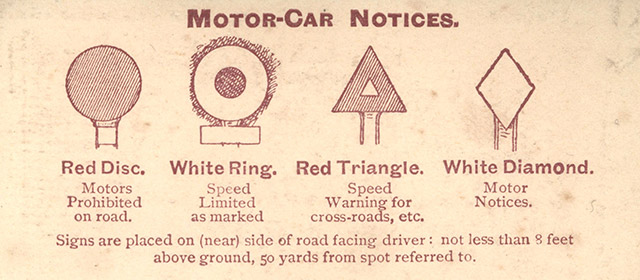 |
The 1904 designs as depicted in Harry R G Inglis, The ‘Contour’ Road Book of England
(Western Division) (Gall & Inglis, London & Edinburgh, 1912-13) |
| |
MINISTRY OF TRANSPORT REGULATIONS
Despite this, the use of unofficial signs remained widespread well into the century. Ministry of Transport Circulars in 1921 and 1930 specified a number of traffic signs of standard form and dimensions but placed no obligation on highway authorities to use them, only a strong recommendation to do so.
During the 1920s the number of vehicles on British roads continued to increase and without a statutory requirement for demonstrating a satisfactory standard of competence to drive, road conditions became increasingly hazardous with many fatal crashes. A private initiative in 1923 was the founding of the National ‘Safety First’ Association which issued booklets containing a large number of hints and tips on safer driving. (In 1941 the Association was renamed the Royal Society for the Prevention of Accidents.) |
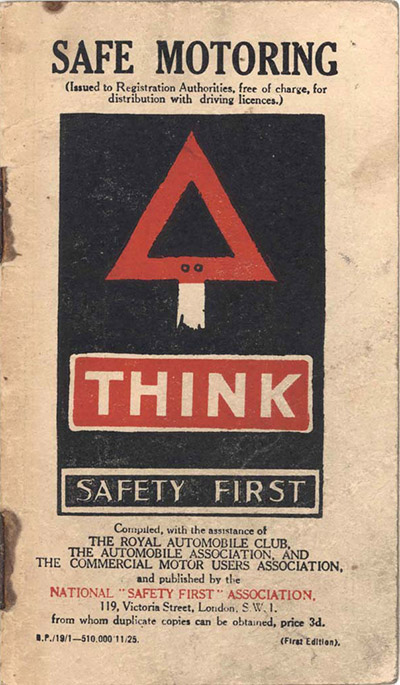 |
 |

The front cover of a booklet issued by
the National ‘Safety First’ Association in
1925 [5½ x 3 inches (129x75 mm)] |
|
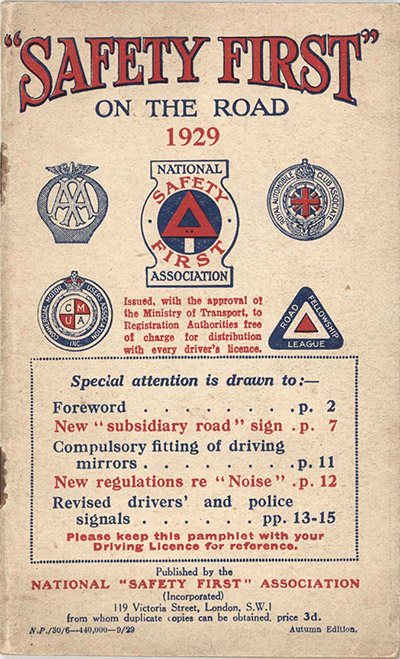 |
 |

Front cover and pages describing road
signs, from a booklet issued by the
National ‘Safety First’ Association in
1929 [5½ x 3⅜ inches (141x86 mm)].
Note the warning against ‘unwarranted
and unofficial notices’. |
|
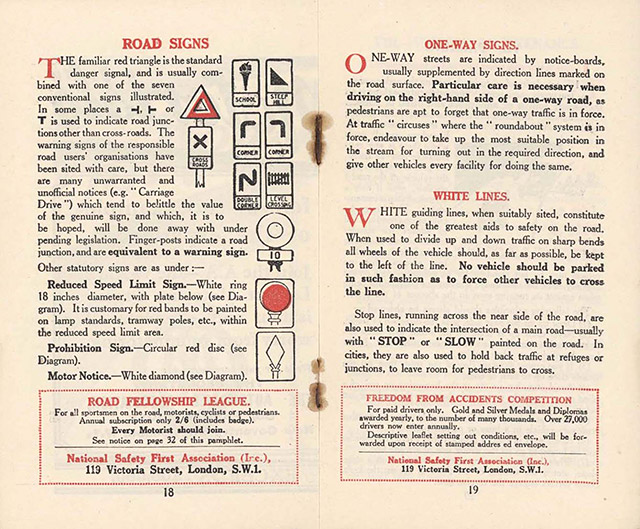 |
The Road Traffic Act, 1930, gave the Minister of Transport powers to prescribe in regulations or otherwise to authorize traffic signs in order to secure a uniform system throughout the country. The Traffic Signs (Size, Colour and Type) Provisional Regulations 1933 and the associated Directions made it illegal to erect signs that did not comply with these regulations unless they had been specially authorized.
Section 45 of the 1930 Act authorized the publication by the Ministry of Transport of The Highway Code, a booklet intended as ‘a supplementary guide to the proper use of the highway, and as a code of good manners to be observed by all courteous and considerate persons’. Curiously, it was not until 1935 that a new edition of the Highway Code included a section on traffic signs.
|
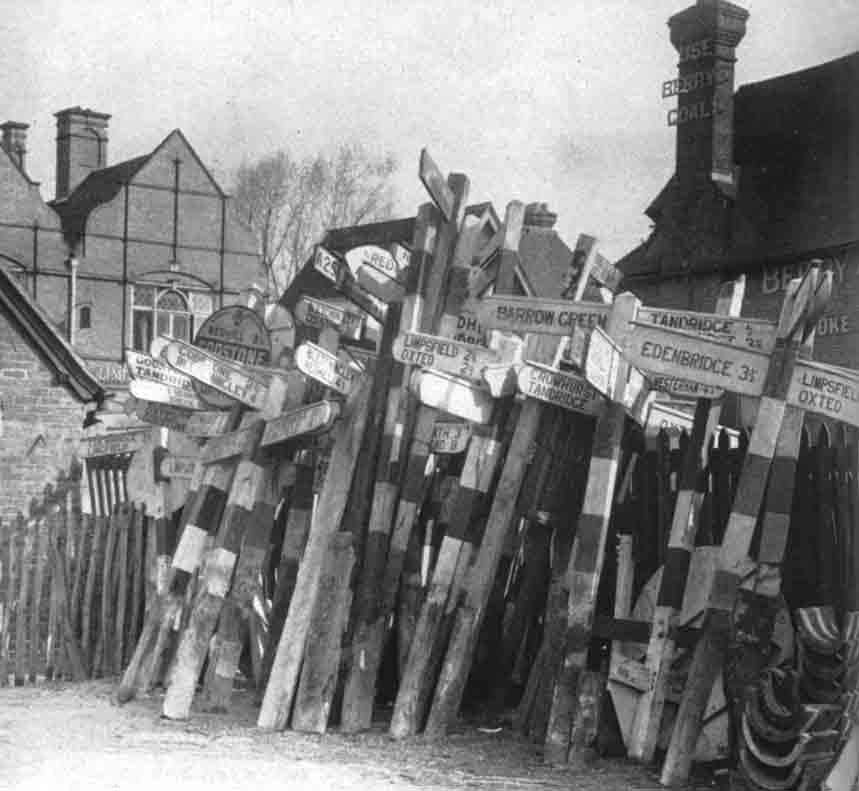 |
Uprooted direction signs stored somewhere in Kent or Surrey in 1940.
Source: Norman Longmate, How We Lived Then: A history of everyday life during the Second World War (Hutchinson, London, 1971). |
| |
In spring 1940, with invasion a real possibility, all direction and place-name identification signs were removed from the roads. Most of these were stored at council depots across the country for the duration, but whether, when peace returned, the original signs were restored to their former locations is hard to ascertain. In 1944 the Minister of War Transport considered that fresh traffic signs regulations would be needed when the war was over. The 1944 Departmental Committee on Road Signs, chaired by Sir Frederick Cook, considered that for traffic signs generally the use of symbols alone without explanatory words (as used in other European countries) was not satisfactory. The Committee’s report laid down the specifications for the shape and size of traffic signs and for the styles of lettering to be used. The local direction sign was to be retained in its existing (pre-war) design, though supplemented by a new type of local approach sign where traffic volume justified it. It is probable that in most instances the restoration of local direction signs involved manufacture of new signs, even if they were similar to those that had been there before. Broadly speaking, the outcome was that British traffic signs continued to evolve and were still recognizably the descendants of the original designs of 1904.
|
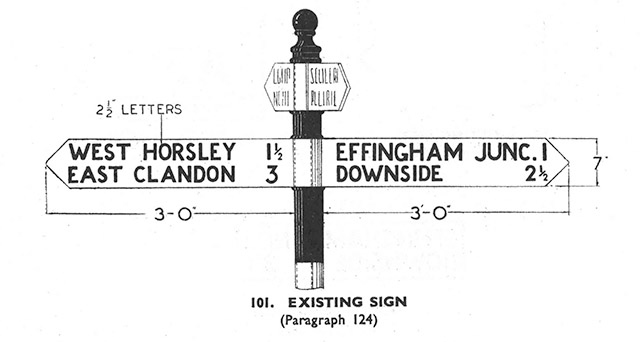 |
Source: Report of the Departmental Committee on Traffic Signs 1944
(London, HMSO, 1946) |
| |
For various reasons, Regulations putting the 1944 Committee’s recommendations into effect were not issued until 1950. A new edition of The Highway Code was issued in 1946 but this devoted only three pages to traffic signs and signals. It was not until the next new edition in 1954 that they received a much larger degree of prominence. They were now divided into groups:
Signs which must be observed
A red ring or a red disc is usually a feature of these signs
Signs which warn
These signs are surmounted by a red triangle
Signs which inform
These signs show where roads lead to, ends of speed limits, parking places, etc
|
| The 1921 Ministry of Transport Circular had specified that the highway authority responsible for the maintenance of local direction signs (at that time usually the local authority) was to be indicated on the post. This was often done by means of a finial (usually circular) bearing its name. After 1945 county councils began to assume responsibility for maintaining direction signs so they may show either the local authority name or that of the county council. In the counties of Berkshire, Dorset and the West Riding of Yorkshire the circular finials gave instead the place name and national grid reference. |
 |
Two examples of pre Worboys fingerposts photographed in June 1989 in what was the West Riding of Yorkshire. These show the National Grid reference incorporated in the circular finial. To the left is at Malham Moor, and to the right at Newby. [courtesy of John Liffen]
|
 |
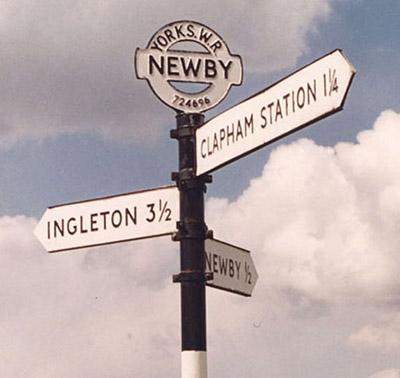 |
|
THE WORBOYS COMMITTEE
Since the 1950s traffic signs of all kinds have been under almost constant review and development in order to keep pace with the ever-increasing speed and volume of motor traffic. The start of the motorway construction programme in 1958 required a complete re-appraisal as the existing signs were considered totally inadequate for the new conditions. A Ministry of Transport Committee under Sir Colin Anderson recommended the use of upper and lower case lettering on a blue background for motorway signs. The results of this experience were available to another Committee chaired by Sir Walter Worboys which sat between 1961 and 1963. Its remit was to review traffic signs on all-purpose roads. These were considered inadequate for a number of reasons: they were too small; more important signs could not be distinguished from others at a distance; they were less effective at night; they relied on a knowledge of English; and they were badly integrated and generally mounted too high in rural areas. The Worboys Committee’s recommendations constituted a complete re-think and re-design of all signs. Contrary to the 1944’s Committee’s view there was now a preference for largely symbolic signing for warning and regulatory signs without the use of words to explain the symbols, and the use of upper- and lower-case lettering was to be adopted for all signs.
The Worboys Committee’s recommendations were generally accepted and were adopted as the Traffic Signs Regulations and General Directions 1964 which came into force on 1 January 1965. It was estimated that it would take five years to replace all superseded traffic signs. Evidence and personal memory suggest that signs in perhaps the most important category, those which must be observed (for example, ‘halt at major road ahead’ and speed limit signs) were replaced quite quickly. However, such exercises can never be completely effective and a fair number of old signs ‘escaped’ this process; not just direction signs but many examples of warning signs as well, perhaps for a couple of decades at least. Many examples of these were identified during surveys made by Doug Rose around 1980 and are illustrated in a separate section of this website. Local direction signs of the ‘fingerboard’ type, being perhaps the least safety-critical, were still to be found in the rural parts of many counties long after this. There was a certain amount of sentimental public resistance to their replacement and in 1975 the Department of Transport relaxed the regulations to allow their continued use on rural roads with low traffic. In built-up areas, however, such signs were already much more scarce and those that remain are now recognized as having ‘heritage’ value, possibly placed on a local authority’s ‘local list’ of historic structures (as in the London Borough of Enfield, see below). At the same time, such signs may require refurbishment as they age. They are also vulnerable to damage, leading to partial or even complete renewal. Consequently what can be seen now might not be ‘original’, whatever that term may be taken to mean.
RESTORING SIGNPOSTS: an Enfield case study
One night during the 2020 Easter weekend a car being chased at high speed by police northwards along Village Road, Enfield EN1, lost control at the junction with Park Avenue, crashed through the boundary wall of St Stephen’s Church and came to rest, badly damaged, in front of the Church itself. In its path was one of Enfield’s local direction signs which it completely demolished. There are only six such signs on Enfield Council’s Local Heritage List so the loss of one of them was quite sad. Even so, it is necessary to retain a sense of proportion concerning the incident. One must feel sympathy for the police who have to carry out such duties, and compassion for the victims of the crash, whatever their misdeeds.
Fortunately Enfield Council decided that a new sign in the likeness of the old should be provided at Park Avenue. Eduardo Gomes, Principal Engineer, Highway Services, therefore contracted Signpost Restoration Limited, based at Brampton, Cumbria, to undertake the work. This specialist company is run by David Gosling and is responsible for the restoration of many historic traffic signs and other roadside features across the UK, see Signpost Restoration Limited (www.signpost-restoration.co.uk).
Signpost Restoration Limited had carried out the last renovation of the Enfield direction signs back in 2007. This time David Gosling needed to supply a complete new post and two new direction ‘fingers’, though one of these was for a similar sign not far away where one of its own ‘fingers’ had been inadvertently transposed from the other at the time David last refurbished the signs back in 2007. Fortunately the circular finial bearing the name of the former local authority (Edmonton UDC) had survived intact and could be re-used. In April 2021, therefore, David visited Enfield to collect the incorrectly-located ‘finger’ for refurbishment. He returned with it on 15th June 2021, also bringing with him the newly-cast components. Working with sub-contractors A H Nicholls & Sons Ltd of Broxbourne he erected the new post at Park Avenue. However, as the foundation cement for the post needed time to cure he had to leave the direction ‘fingers’ with the sub-contractors for them to fit a day or two later. David then travelled to the other sign a quarter of a mile south along Village Road where he fitted the ‘finger’ showing the correct mileages.

|
(Top left) A day or two after the incident at Easter 2021 the speeding car’s tyre tracks were still visible on the grass. (Top right) All that remained of the local direction sign after the car had demolished it. (Middle left) On 15th June 2021 David Gosling (on the right) watches as the post for the new sign at Park Avenue EN1 is lifted into place. (Middle right) He then inserts the fitting which holds the collars for the direction‘fingers’. (Bottom left) At the junction of Village Road with Ridge Avenue, David lifts out the new ‘finger’ for the other sign. (Bottom right) Having fitted it he then re-assembles the rest of the signpost. |
It can be seen that these refurbished signs capture their familiar looks very well. Ideally the lettering should be of the Ministry of Transport standard alphabet promulgated in successive editions of the Traffic Signs Regulations between 1933 and 1957. However, David cannot source satisfactory moulds for casting MoT lettering so for his new castings he uses a version of Helvetica lettering which he feels is a close enough match. It is largely thanks to David Gosling and his company Signpost Restoration Limited that so many historic traffic signs remain in good condition to provide character and interest to our town and country landscapes.
FURTHER READING
The literature on traffic signs is not extensive but in addition to government reports and legislation the following sources may be found of interest.
Big Chief I-Spy [Charles Warrell], I-Spy On The Road
(London, no date but c.1953, also later reprints) [5x4 inches (130x100mm)] |
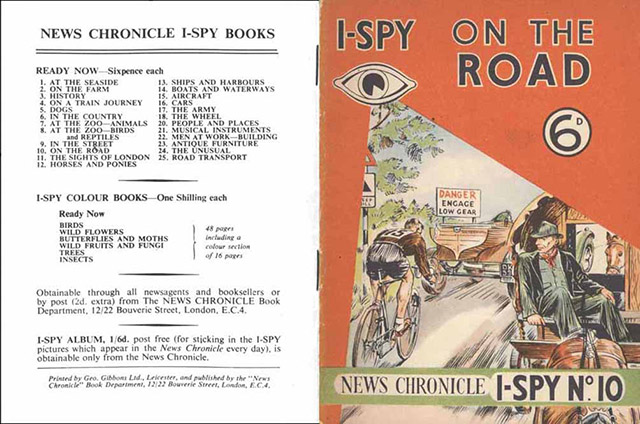 |
Andrew Emmerson and Peter Bancroft, A, B, C and M: Road Numbering Revealed (Capital History, Harrow, 2007) [A5 (148.5x210mm)] |
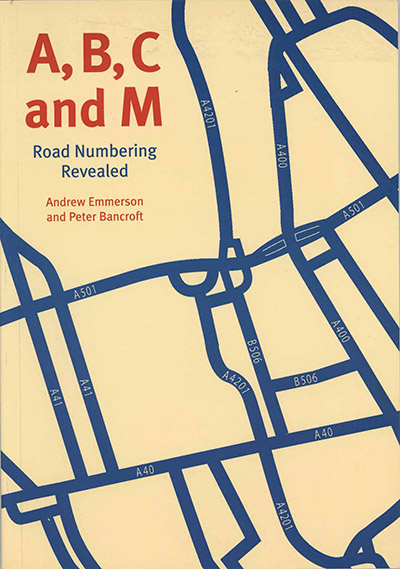 |
Stuart Hands, Road Signs (Shire Books, Princes Risborough, 2002)
[and minor amended re-print, Botley, 2002] [A5 (210x148mm)] |
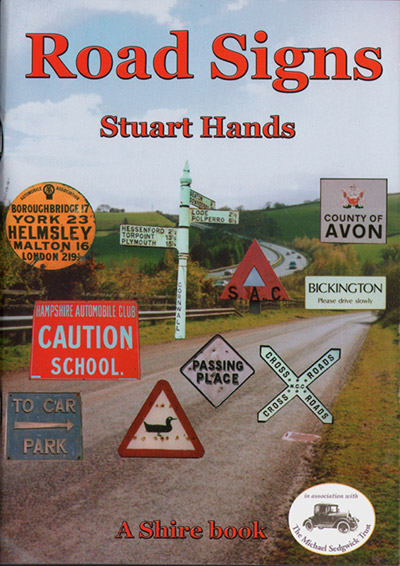 |
The Highway Code (successive editions, 1931 to date, though selected traffic signs were not illustrated until about 1935). |
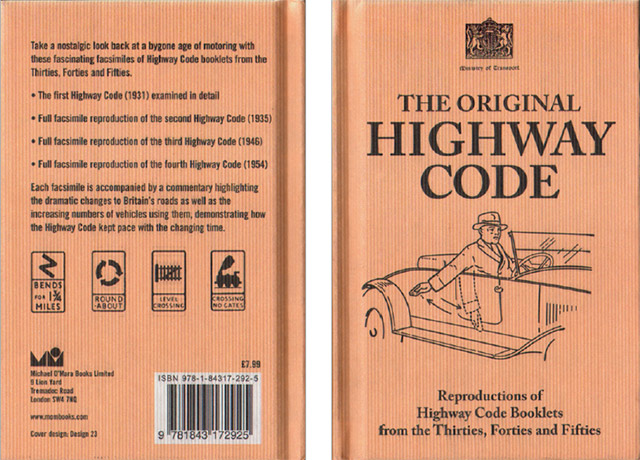 |
This hardback book was published by Michael O’Mara Books in 2008. It contains a background narrative on ‘The Birth of the Highway Code’, and complete facsimiles of editions from 1935, 1946 and 1954. [6⅝ x 4½ inches (170x114mm)] |
| |
J A Hughes, abc British Roads (Ian Allan Ltd, London, 1956)
[6 x 4⅛ inches (154x105mm)]
|
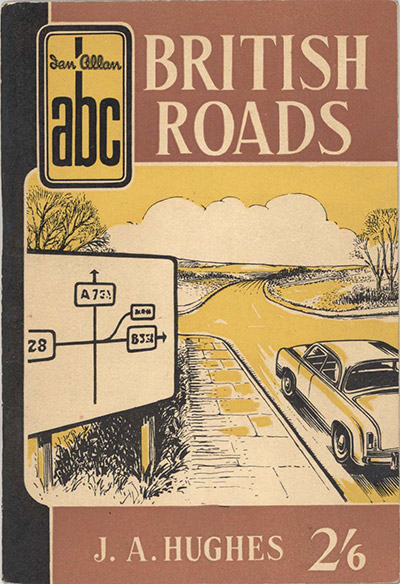 |
The New Traffic Signs (HMSO, 1965 and re-prints) [7 x 4½ inches (180x117mm)] |
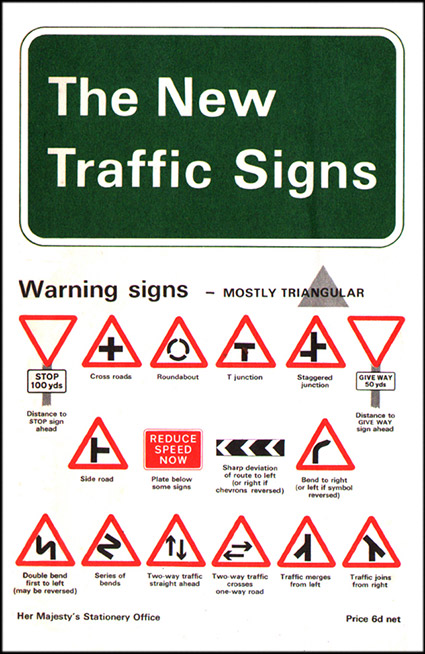 |
The History of British Traffic Signs (Department of Transport, 1991,
2nd edition, revised, 1999). [A4 (297x210mm)] |
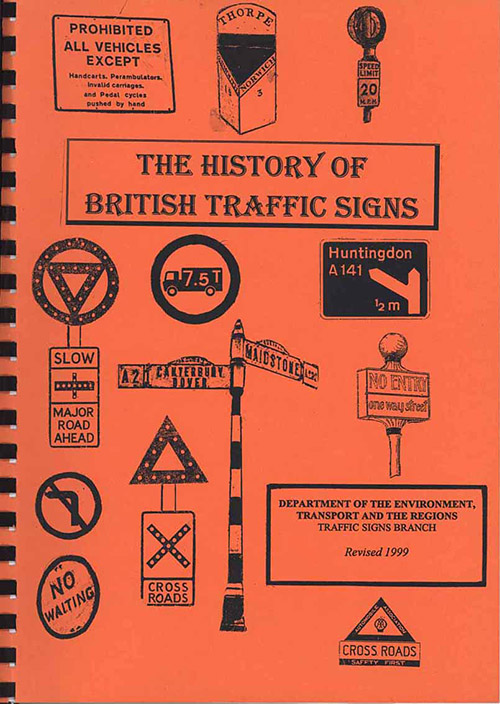 |
| |
https://www.roads.org.uk/ (formerly ‘Chris’s British Road Directory’),
accessed 6th July 2020 |
| |
| < back to the main Street Furniture page |
| |
| * * * |
| |
|
|